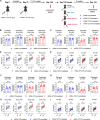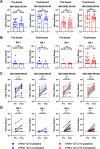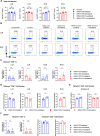Ipsilateral or contralateral boosting of mice with mRNA vaccines confers equivalent immunity and protection against a SARS-CoV-2 Omicron strain
- PMID: 39194250
- PMCID: PMC11406931
- DOI: 10.1128/jvi.00574-24
Ipsilateral or contralateral boosting of mice with mRNA vaccines confers equivalent immunity and protection against a SARS-CoV-2 Omicron strain
Abstract
Boosting with mRNA vaccines encoding variant-matched spike proteins has been implemented to mitigate their reduced efficacy against emerging SARS-CoV-2 variants. Nonetheless, in humans, it remains unclear whether boosting in the ipsilateral or contralateral arm with respect to the priming doses impacts immunity and protection. Here, we boosted K18-hACE2 mice with either monovalent mRNA-1273 (Wuhan-1 spike) or bivalent mRNA-1273.214 (Wuhan-1 + BA.1 spike) vaccine in the ipsilateral or contralateral leg after a two-dose priming series with mRNA-1273. Boosting in the ipsilateral or contralateral leg elicited equivalent levels of serum IgG and neutralizing antibody responses against Wuhan-1 and BA.1. While contralateral boosting with mRNA vaccines resulted in the expansion of spike-specific B and T cells beyond the ipsilateral draining lymph node (DLN) to the contralateral DLN, administration of a third mRNA vaccine dose at either site resulted in similar levels of antigen-specific germinal center B cells, plasmablasts/plasma cells, T follicular helper cells, and CD8+ T cells in the DLNs and the spleen. Furthermore, ipsilateral and contralateral boosting with mRNA-1273 or mRNA-1273.214 vaccines conferred similar homologous or heterologous immune protection against SARS-CoV-2 BA.1 virus challenge with equivalent reductions in viral RNA and infectious virus in the nasal turbinates and lungs. Collectively, our data show limited differences in B and T cell immune responses after ipsilateral and contralateral site boosting by mRNA vaccines that do not substantively impact protection against an Omicron strain.IMPORTANCESequential boosting with mRNA vaccines has been an effective strategy to overcome waning immunity and neutralization escape by emerging SARS-CoV-2 variants. However, it remains unclear how the site of boosting relative to the primary vaccination series shapes optimal immune responses or breadth of protection against variants. In K18-hACE2 transgenic mice, we observed that intramuscular boosting with historical monovalent or variant-matched bivalent vaccines in the ipsilateral or contralateral limb elicited comparable levels of serum spike-specific antibody and antigen-specific B and T cell responses. Moreover, boosting on either side conferred equivalent protection against a SARS-CoV-2 Omicron challenge strain. Our data in mice suggest that the site of intramuscular boosting with an mRNA vaccine does not substantially impact immunity or protection against SARS-CoV-2 infection.
Keywords: B-cell responses; SARS-CoV-2; T cell responses; immunity; infection; vaccine.
Conflict of interest statement
M.S.D. is a consultant or advisor for Inbios, Vir Biotechnology, IntegerBio, Moderna, Merck, GlaxoSmithKline, and Marshall, Gerstein and Borun. The Diamond laboratory has received unrelated funding support in sponsored research agreements from Vir Biotechnology, Emergent BioSolutions, and IntegerBio. S.M.E. and D.K.E. are employees and shareholders in Moderna Inc. All other authors declare no conflicts of interest.
Figures






Similar articles
-
Comparison of a SARS-CoV-2 mRNA booster immunization containing additional antigens to a spike-based mRNA vaccine against Omicron BA.5 infection in hACE2 mice.PLoS One. 2024 Dec 3;19(12):e0314061. doi: 10.1371/journal.pone.0314061. eCollection 2024. PLoS One. 2024. PMID: 39625929 Free PMC article.
-
MVA-based vaccine candidates expressing SARS-CoV-2 prefusion-stabilized spike proteins of the Wuhan, Beta or Omicron BA.1 variants protect transgenic K18-hACE2 mice against Omicron infection and elicit robust and broad specific humoral and cellular immune responses.Front Immunol. 2024 Aug 29;15:1420304. doi: 10.3389/fimmu.2024.1420304. eCollection 2024. Front Immunol. 2024. PMID: 39267752 Free PMC article.
-
Imprinting of serum neutralizing antibodies by Wuhan-1 mRNA vaccines.Nature. 2024 Jun;630(8018):950-960. doi: 10.1038/s41586-024-07539-1. Epub 2024 May 15. Nature. 2024. PMID: 38749479 Free PMC article.
-
Immunological mechanisms of vaccine-induced protection against COVID-19 in humans.Nat Rev Immunol. 2021 Aug;21(8):475-484. doi: 10.1038/s41577-021-00578-z. Epub 2021 Jul 1. Nat Rev Immunol. 2021. PMID: 34211186 Free PMC article. Review.
-
Durability of immune responses to SARS-CoV-2 infection and vaccination.Semin Immunol. 2024 May;73:101884. doi: 10.1016/j.smim.2024.101884. Epub 2024 Jun 10. Semin Immunol. 2024. PMID: 38861769 Review.
References
-
- Liu L, Iketani S, Guo Y, Chan JF-W, Wang M, Liu L, Luo Y, Chu H, Huang Y, Nair MS, Yu J, Chik KK-H, Yuen TT-T, Yoon C, To KK-W, Chen H, Yin MT, Sobieszczyk ME, Huang Y, Wang HH, Sheng Z, Yuen K-Y, Ho DD. 2022. Striking antibody evasion manifested by the Omicron variant of SARS-CoV-2. Nature New Biol 602:676–681. doi:10.1038/s41586-021-04388-0 - DOI - PubMed
-
- Lau JJ, Cheng SMS, Leung K, Lee CK, Hachim A, Tsang LCH, Yam KWH, Chaothai S, Kwan KKH, Chai ZYH, Lo THK, Mori M, Wu C, Valkenburg SA, Amarasinghe GK, Lau EHY, Hui DSC, Leung GM, Peiris M, Wu JT. 2023. Real-world COVID-19 vaccine effectiveness against the Omicron BA.2 variant in a SARS-CoV-2 infection-naive population. Nat Med 29:348–357. doi:10.1038/s41591-023-02219-5 - DOI - PMC - PubMed
MeSH terms
Substances
Supplementary concepts
Grants and funding
LinkOut - more resources
Full Text Sources
Medical
Molecular Biology Databases
Research Materials
Miscellaneous

